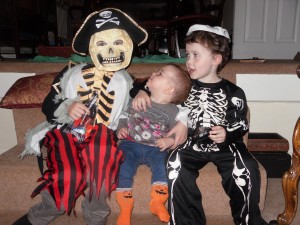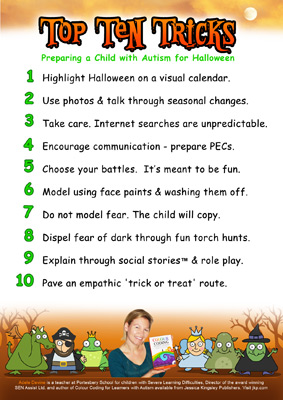Walking around the shops in October it is impossible to escape the ghoulish Halloween theme. The supermarkets are full of masks, deathly hands and creepy cobwebs. A child may shrug this off as you walk them quickly past displays, which are a little too creepy for comfort.
But let’s think about the child with autism. These children often have a different way of processing, heightened or jumbled perception and sensory issues. How might they perceive those costumes, decorations and unexplained changes?
The best way to understand is to try walking in their shoes…

Shops.
You are now a child with autism entering a supermarket.
The volume has been put up and every individual noise is becoming unbearably loud. The sound of a trolley is like thunder clashing, those sliding doors are nails down a blackboard screeching as they open and close, open and close. Colour is gone and the lighting creates a nightmare strobe effect coupled with a continuous, loud hum, which feels like bees moving about and buzzing inside your ears. Your senses are all muddled. Revolting shop smells of food and body odours, do not stop at your nose, but become sickening tastes. Your mouth is dry. The floor seems to wobble and your clothes begin to grate and chaff and burn into your skin. You anticipate these feelings, but at least you know this shop. You know the routine. You’ve been here before and survived…
But wait!
Suddenly there is an isle of terror where the toys usually are. That piano with the coloured buttons, which is the ONLY reason you’ve ever endured this shop has been replaced by a cauldron full of skeletons and black spiders. That Lego set you’ve been told to “wait for until your birthday” is GONE too! You zoom in and take in every detail – image after image like the ‘click, click, click’ of a camera. It’s fascinating, but also terrifying. You’ll think about it later. It is all too different and uncomfortable right now. Images will be stored for when are home and feel safe – maybe bedtime?
Dressing up.
Maybe you hate dressing up or seeing other people dressed up. Maybe you recognise people by what they wear and the sameness of style makes you feel more secure. Maybe dressing up makes you feel you must become that character. If you are dressed as a tiger then you feel like a tiger. Grown up’s don’t seem to get this and keep telling you off as you leap about roaring and scratching…
Face Paints
Maybe you find face paints frightening – the sad clown with a painted smile. Is it happy or sad? Good or bad? Facial expressions are already confusing, without throwing face paints in to the mix. Maybe someone wants you to wear face paints, but you have a sensory fear or do not realise that those paints are only temporary. Maybe the face paints are okay, but you have a deep, scratchy memory of the face washing after.
Trick or Treat?
Now there are knocks on the door after dark and you see Mum or Dad giving away your sweets to other children. When will it end? Maybe Mum and Dad turn the lights out and neighbours know not to knock on your door. But then there are the neighbours, who still welcome trick or treating. They make this clear with decorations – a friendly pumpkin or a full on fright house…
What can we do to help?
Whether you choose to get involved with Halloween or not it is important to prepare a child with autism for the run up to October 31st.
Here are my top 10 tricks to preparing a child with Autism for Halloween.
Click Here to download a poster of the top 10 tricks to prepare a child for Halloween
Adele Devine is the author of Colour Coding for Learners with Autism now available from Jessica Kingsley Publishers
